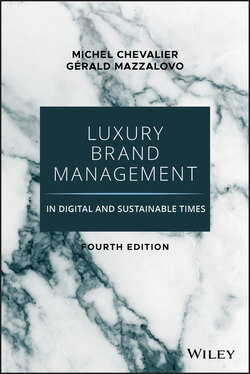Читать книгу Luxury Brand Management in Digital and Sustainable Times - Michel Chevalier - Страница 49
Turnaround Time
ОглавлениеFor the reasons mentioned, in the luxury field there is no short-term impact of major strategic decisions. For a luxury fashion brand, for example, the results of changing the designer might not be seen until two or three years down the road.
Brands themselves cannot be modified overnight. They have a specific identity in the mind of the consumer, and it is difficult to modify this. Celine, for example, is a very feminine brand and its attempts to launch masculine products have been conspicuously unsuccessful. Paco Rabanne is, curiously, a designer for women, but the brand was mainly known for masculine perfumes until the One Million lady was a success. Some brands are modern, others are perceived as traditional. It is very difficult to change such perceptions. Chanel is a brand for women, but it also has fragrances, ties, and watches for men. At the moment, it does not have a strong men's ready-to-wear; in the long run, it probably will. But this is a major change that the brand is preparing for by presenting its masculine products at its fashion shows for women. The idea is to convince the customer that Chanel is a brand for both women and men. This may take some time, and its men's ready-to-wear products are not yet available in the stores. When the consumer changes his mind, they will be.
It takes time to turn a brand around, as the experience of Saint Laurent clearly shows. When the fashion brand was purchased by the Gucci Group, everybody thought the turnaround in its fortunes would be rapid. However, with accumulated losses already amounting to several hundred million euros, the brand continued to lose money for a few more years before it started to turn around in 2013 and is now extremely successful.
This has major implications for investors who want to buy and redevelop a brand that has lost its image and sales. This may be possible for watches and for wines and spirits, but for fashion and perfumes it is very difficult. If a brand is not doing well, its identity must be modified over time. The paradox is that when this is done, customers have the feeling that the brand has been mishandled and its history betrayed. In the end, nobody is happy—unless a great deal of time, effort, and money are committed to the cause.
Of course, as we explain later, it has been possible to take brands such as Gucci and Burberry, which were doing relatively well, modify them over time, and increase their sales substantially. But when smaller brands such as Jacques Fath or Poppy Moreni have lost their glamour, their interest, and their reason for being, there is not much that can be done to bring them back into the limelight.
This time frame explains why private-equity specialists or private individuals seldom purchase a majority of small luxury brands. There are exceptions—Balenciaga, Balmain, or Versace—but turnarounds are seldom successful.
This is why this activity has been traditionally the field of family firms, which have time and can accept poor results for a few years before growing and making money again. There are many in this situation, including Chanel, Salvatore Ferragamo, Armani, Versace, Laurent-Perrier, and Pernod Ricard. And we should never forget that three of the major luxury groups, LVMH, Kering, Richemont, are also controlled by families. In fact, except for a few examples (Burberry, Diageo, Hugo Boss, or Helmut Lang), all luxury companies in France, Italy, the United States, China, and Japan are family controlled or belong to a group which, in turn, is also family controlled.
